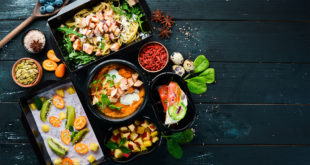 Since 1993, the FDA has required manufacturers to print nutrition labels on food packages. As Americans become increasingly obese, health-consciousness has powered the trend toward full nutrition disclosure in restaurants as well. The theory is that if we see the caloric impact of foods, we will make healthier choices and lose weight collectively. One study showed that even a tiny change in eating habits among just 10 percent of the population would avert a whopping 39 percent of weight gain for the whole population. That’s a serious benefit!
Since 1993, the FDA has required manufacturers to print nutrition labels on food packages. As Americans become increasingly obese, health-consciousness has powered the trend toward full nutrition disclosure in restaurants as well. The theory is that if we see the caloric impact of foods, we will make healthier choices and lose weight collectively. One study showed that even a tiny change in eating habits among just 10 percent of the population would avert a whopping 39 percent of weight gain for the whole population. That’s a serious benefit!
So, are restaurants jumping at the chance to display calorie contents on their menu boards? Not exactly. A Purdue University study examined the obstacles for restaurant operators that prevented them from analyzing their menus’ nutrition and labeling their menus. At the time of the survey, which was conducted in 1994, only about 39 percent of top-grossing restaurant chains were voluntarily analyzing the nutrition of their menu items. In most eateries, nutrition info was available upon request, but not as a part of menus.
Although the survey was conducted 15 years ago, the obstacles to menu-labeling remain. Some reasons survey respondents gave for not analyzing menu-item nutrition:
- Too many menu variations
- Limited space on the menu for labeling
- Difficulty in training personnel to implement labeling
- Not enough time to implement labeling
- Variations in ingredients
- Variations in preparation based on diners’ special requests
- Inadequacy of nutrient database information
- Cost of laboratory analysis of nutrition
- Inconsistency in portion size
Today, operators would likely cite these same obstacles preventing them from labeling their menus. Personnel issues aside, the cost of nutrition analysis alone would be prohibitive to most small-scale operations. But the i-COOK Professional system offers a free and simple solution.
i-COOK Professional is free for a limited time. That means that an e-mail address is all operators need to gain unlimited access to the nutrition analysis based on ESHA data, which maps more than 30,000 ingredients. Try it today at http://www.icookprofessional.com.
Source: Almanza, Barbara A., Stella Chai, and Douglas Nelson. “Obstacles to nutrition labeling in restaurants.” Journal of the American Dietetic Association. 97.2 (1997): 157-161.
 Corner Booth Blog | TundraFMP Restaurant Supply, News & Equipment Blog
Corner Booth Blog | TundraFMP Restaurant Supply, News & Equipment Blog




A message to ALL restaurants: Be responsible, do the right thing and communicate the nutritional information to your guests. Your guests will view you and your restaurant as an establishment that has their best interests in mind. It will also urge you to offer healthier options and you’ll find you won’t give up quality or taste!
In addition, it will be healthy for your bottom line if it’s marketed well!